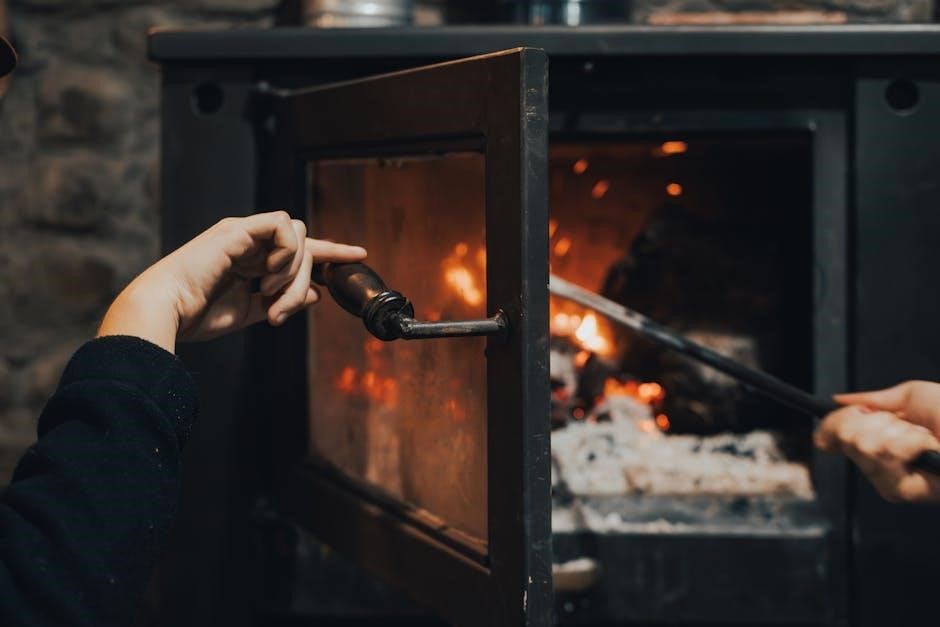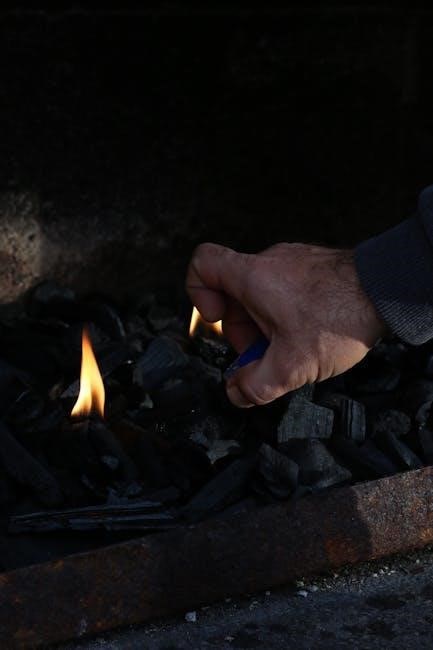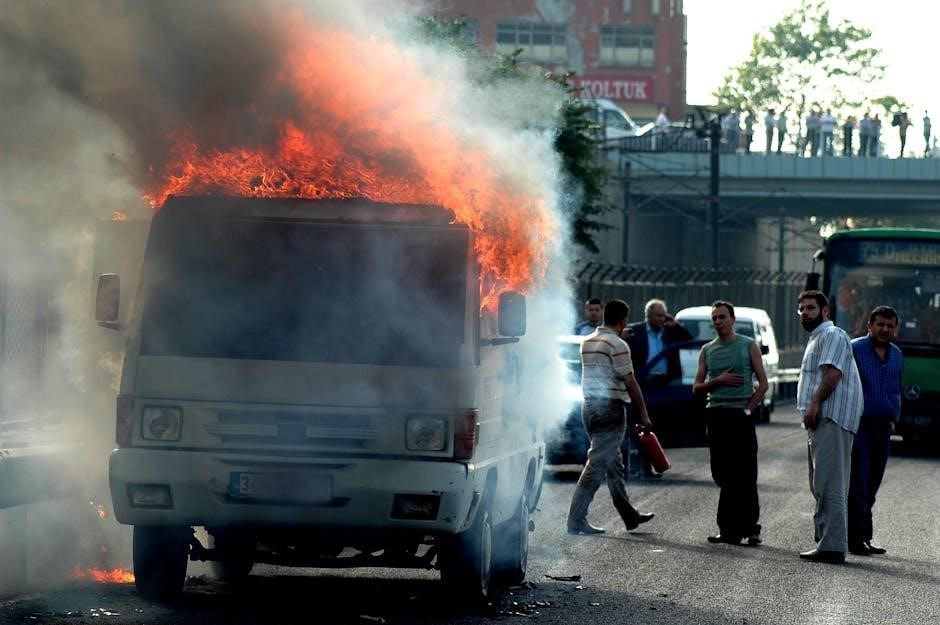Welcome to the Firex Smoke Alarm Owner’s Manual, your essential guide to understanding, installing, and maintaining your smoke alarm system for enhanced home safety and compliance.
Overview of the Firex Smoke Alarm System
The Firex Smoke Alarm System is designed to provide reliable fire detection and early warning, ensuring home and family safety. It offers a comprehensive range of features, including interconnectivity with multiple devices, advanced sensors, and battery backup options. The system supports both ionization and photoelectric technologies, catering to different detection needs. With UL certification and compliance with local fire codes, Firex alarms meet rigorous safety standards. The system is expandable, allowing connection with up to 18 devices, including smoke and heat alarms, for whole-home protection; Regular maintenance and testing are simplified, ensuring optimal performance and peace of mind.

Product Features and Specifications
The Firex Smoke Alarm features advanced detection technologies, including ionization and photoelectric sensors, with AC power and battery backup options. It meets UL certification standards, ensuring reliability and safety.
Types of Firex Smoke Alarms
Firex offers various smoke alarm models, including ionization and photoelectric sensors. The i4618AC Series features direct wire with battery backup, while the FX1218 model includes advanced silence and test features. Other models like the FADC and AD series provide compatibility with heat alarms. All Firex smoke alarms are designed for reliability and meet UL standards, ensuring comprehensive home protection. Each model caters to different installation needs, offering options for hardwired or battery-powered systems. Proper selection ensures optimal fire detection and compliance with safety regulations.
Power Sources: AC and Battery Backup
Firex smoke alarms are powered by a 120V AC connection with a 9-volt battery backup, ensuring continuous operation during power outages. The battery backup provides added protection and reliability, while the AC power ensures consistent functionality. The unique power connector prevents interconnection with incompatible devices, maintaining system integrity. This dual-power design enhances safety by minimizing downtime and ensuring alarms remain active even during electrical failures. Regular battery monitoring is recommended to maintain optimal performance and reliability. This feature-rich power system is designed to provide peace of mind and comprehensive protection for your home and family.
Key Technologies: Ionization and Photoelectric Sensors
Firex smoke alarms utilize advanced detection technologies, including ionization and photoelectric sensors, to provide reliable fire detection. Ionization sensors detect fast-flaming fires by identifying changes in air molecules, while photoelectric sensors identify slow, smoldering fires by detecting light scattering caused by smoke particles. Some models combine both technologies for comprehensive protection. These sensors ensure quick and accurate alerts, enhancing home safety. The dual-sensor design minimizes false alarms while maximizing detection capabilities, offering homeowners peace of mind with cutting-edge fire detection technology tailored to various fire scenarios and conditions.
Interconnectivity with Other Firex Devices
Firex smoke alarms can be interconnected with up to 11 other compatible Firex smoke alarms and 6 heat alarms, totaling 18 devices. This interconnectivity ensures that when one alarm detects smoke, all connected units sound, providing comprehensive coverage. The system enhances safety by alerting occupants throughout the home. Compatible models include FADC, AD, ADC, and FX1218 series. Proper interconnection requires following installation guidelines to ensure seamless communication. Always use Firex-approved connectors to maintain reliability and avoid compatibility issues. This feature is ideal for larger homes, ensuring no area is left unmonitored. Refer to the manual for specific wiring and setup instructions.

Installation Instructions
Follow step-by-step guides for proper smoke alarm installation, ensuring optimal performance and safety. Refer to manual for wiring, mounting, and interconnectivity instructions.
Recommended Locations for Smoke Alarms
Smoke alarms should be installed on every level of your home, including basements and attics. Place one inside each sleeping area and outside each bedroom door. Install alarms in hallways leading to bedrooms and near kitchens, but not within 10 feet of cooking appliances to avoid false alarms. For optimal detection, mount alarms on ceilings or walls, at least 12 inches away from corners. Ensure at least one alarm is within 21 feet of any bedroom door. Avoid areas prone to steam or moisture, such as bathrooms, to prevent malfunction. Proper placement ensures early detection and enhances home safety.
Locations to Avoid for Optimal Performance
Install smoke alarms at least 10 feet away from cooking appliances to reduce false alarms caused by smoke and fumes. Avoid placing alarms in bathrooms, laundry rooms, or areas with high humidity, as moisture can interfere with sensor accuracy. Do not install alarms near drafty windows, doors, or vents, as airflow may disperse smoke, delaying detection. Avoid areas near furnaces, water heaters, or fireplaces, as combustion byproducts can trigger false alarms. Keep alarms away from dusty areas, like workshops, to prevent dust from affecting sensitivity. Proper placement ensures reliable performance and minimizes nuisance alarms.
Step-by-Step Installation Guide
Begin by selecting a suitable location for your Firex smoke alarm, ensuring compliance with local fire codes and manufacturer recommendations. Turn off power at the circuit breaker if hardwiring. Mount the bracket to the wall or ceiling using screws or anchors. Attach the smoke alarm to the bracket, ensuring it clicks securely into place. For hardwired models, connect the wires to the terminal screws, matching black to black, white to white, and copper to the ground. Insert the backup battery, ensuring proper orientation. Restore power and test the alarm by pressing the test button to confirm proper operation. Refer to the manual for additional details.
Interconnecting Multiple Smoke Alarms
Interconnecting Firex smoke alarms ensures all units activate if one detects smoke, enhancing home safety. Use compatible models like FADC, AD, ADC, and PAD, with a maximum of 18 interconnected devices. Connect via the interconnect wire or communication cable to link alarms. Ensure all units are correctly wired, following manual instructions. Test the system by triggering one alarm to verify all interconnected units sound. Refer to the manual’s diagrams and guidelines for proper installation and troubleshooting. This setup ensures comprehensive coverage and meets safety standards.
Troubleshooting Common Installation Issues
Common installation issues include improper wiring, incorrect placement, or incompatible devices. Ensure all alarms are wired correctly and interconnected models are compatible. Check power sources, as AC or battery issues can prevent proper function. Verify that no alarms are damaged or tampered with. If interconnected systems fail to activate, inspect connections and wiring. Refer to the manual for diagrams and troubleshooting guides. Test alarms post-installation to confirm functionality. Addressing these issues ensures your system operates reliably, providing optimal fire detection and safety for your home.

Operation and Testing
Regular testing ensures your Firex smoke alarm functions correctly. Test all alarms monthly using the test button. Check for proper power and connectivity in interconnected systems.
Understanding the Alarm Sounds and Indicators
Familiarize yourself with your Firex smoke alarm’s sounds and indicators. A steady chirp signals a low battery, while three consecutive beeps indicate smoke detection. The Hush button silences nuisance alarms temporarily. LED lights flash during activation or error states. Use the test button to ensure proper functionality. Regularly check indicators to maintain optimal performance and safety. Refer to the manual for detailed explanations of all sounds and visual cues to ensure timely responses to alarms. Proper understanding ensures effective use and enhances home safety.
Daily Checks and Routine Testing
Perform daily checks to ensure your Firex smoke alarm operates correctly. Press the test button to verify the alarm sounds and LED lights function properly. Check battery levels if applicable, as low batteries may cause chirping. Inspect for dust or debris that could interfere with sensor accuracy. For interconnected systems, test all units together to confirm they communicate effectively. Use the Hush button to silence nuisance alarms temporarily, but address the underlying cause promptly. Regular testing ensures your smoke alarm is ready to respond in case of an emergency, providing peace of mind and reliable protection for your home and family.
Testing Interconnected Smoke Alarm Systems
Testing interconnected Firex smoke alarms ensures all devices function together seamlessly. Press the test button on one unit to trigger a synchronized alarm response across all connected devices. Verify that each smoke alarm sounds and its LED illuminates. For systems with heat alarms, ensure they activate appropriately during testing. If any unit fails to respond, refer to the troubleshooting section. Use the Hush button to silence nuisance alarms temporarily, but address the cause promptly. Regular testing of interconnected systems guarantees reliable performance and comprehensive protection in case of emergencies, providing peace of mind for your home and family.
Using the Hush Button for Nuisance Alarms
The Hush button on your Firex smoke alarm allows you to silence nuisance alarms caused by cooking smoke or steam. Press and hold the button until the alarm stops. Note that this feature temporarily desensitizes the sensor but does not disable it. The alarm will automatically reset after a few minutes. Avoid overusing the Hush button, as frequent false alarms may indicate a need for cleaning or relocating the unit. Always address the root cause of nuisance alarms to ensure optimal performance and safety. This feature is convenient for temporary situations but should not replace regular maintenance or testing.

Maintenance and Upkeep
Regularly clean the smoke alarm to ensure proper functioning. Replace batteries annually or as indicated. Inspect sensors for dust and debris to maintain accuracy and reliability.
Cleaning the Smoke Alarm for Proper Functioning
Cleaning your Firex smoke alarm is crucial for ensuring accurate detection and reliability. Use a soft, dry cloth or a vacuum cleaner to gently remove dust and debris from the exterior and sensor chamber. Avoid using harsh chemicals, as they may damage the unit or interfere with its performance. For stubborn dust, a can of compressed air can be used, but always follow the manufacturer’s instructions. Regular cleaning prevents false alarms and ensures the alarm operates effectively in case of an emergency. Perform this maintenance every 30 days for optimal functionality and safety.
Replacing Batteries and Monitoring Power Levels
Regular battery replacement and power level monitoring are essential to ensure your Firex smoke alarm operates reliably. For battery-powered models, replace the 9-volt battery annually or when the low-battery chirp sounds. Turn off power at the circuit breaker for hardwired units before replacing batteries. Use high-quality alkaline batteries for optimal performance. Avoid using rechargeable batteries, as they may not provide consistent power. After installation, test the alarm to confirm proper functionality. Monitoring power levels ensures uninterrupted protection, especially during power outages. Always refer to the manufacturer’s guidelines for specific instructions tailored to your Firex smoke alarm model.
When to Replace the Smoke Alarm
Replace your Firex smoke alarm every 10 years or sooner if it shows signs of wear, such as cracked housings, yellowing, or reduced sensitivity. If the alarm fails to respond to smoke during testing, it should be replaced immediately. Additionally, if the unit is damaged by fire, water, or excessive humidity, replacement is necessary. Always use a Firex-branded replacement to ensure compatibility and safety. For hardwired models, turn off power before replacing. Proper replacement ensures continuous protection and compliance with safety standards. Refer to the manual for specific instructions tailored to your model.

Handling False Alarms and Nuisance Alarms
False alarms occur due to cooking fumes, steam, or dust. Use the Hush button to silence nuisance alarms temporarily. Ensure proper cleaning to reduce false triggers.
Causes of False Alarms
False alarms in Firex smoke alarms are often triggered by non-emergency conditions. Common causes include cooking fumes, steam from showers, or dust particles in the air. Smoke from candles, cigarettes, or fireplaces can also activate the alarm. Additionally, insect interference or improper installation may lead to false triggers. Regular cleaning of the sensor chamber helps reduce nuisance alarms. It’s important to identify and address the source of false alarms to ensure the device operates accurately. Refer to the troubleshooting section for guidance on resolving these issues and maintaining reliable performance.
Reducing Nuisance Alarms
To minimize false alarms, ensure your Firex smoke alarm is installed at least 10 feet away from cooking appliances and not near bathrooms or laundry areas prone to steam. Use the Hush button to temporarily silence nuisance alarms caused by cooking or showering. Regularly clean the sensor chamber to remove dust and debris. Avoid installing alarms near drafty windows or areas with high humidity. Consider upgrading to a smoke alarm with a photoelectric sensor, which is less prone to false alarms from cooking fumes. Proper installation and maintenance can significantly reduce false triggers, ensuring your alarm responds only to actual threats.
Resetting the Smoke Alarm
To reset your Firex smoke alarm, first silence the alarm by pressing and holding the Hush button or using a fan to clear the air. If the alarm chirps or shows an error code, check the power source and ensure the battery is fully charged or replaced. For hardwired models, turn off the power at the circuit breaker, wait 30 seconds, and restore power. Clean the sensor chamber to remove dust or debris that may trigger false alarms. Ensure proper installation and wiring to prevent malfunctions. Refer to the troubleshooting guide for specific error codes and solutions. Resetting ensures your alarm functions correctly for optimal safety.

Compliance and Safety Standards
Firex smoke alarms meet strict UL certification, comply with local and national fire codes, and adhere to EN standards, ensuring reliable protection and regulatory compliance for your safety.
UL (Underwriters Laboratories) Certification
Firex smoke alarms are UL-certified, meeting rigorous safety and performance standards set by Underwriters Laboratories. This certification ensures that the devices detect smoke and alert occupants reliably, providing a critical layer of fire protection. Firex smoke alarms undergo extensive testing for sensitivity, durability, and functionality, guaranteeing they meet or exceed industry requirements. The UL mark signifies compliance with safety standards, offering homeowners peace of mind and reliable protection.
Meets Local and National Fire Codes
Firex smoke alarms are designed to meet both local and national fire codes, ensuring compliance with safety regulations. These alarms are tested to standards set by organizations like the National Fire Protection Association (NFPA) and the International Residential Code (IRC). By adhering to these codes, Firex smoke alarms provide reliable fire detection and alert systems, helping to protect lives and property. Compliance with these standards ensures that the alarms function as expected during emergencies, offering homeowners peace of mind and legal assurance of proper fire safety measures.
EN (European Norm) Compliance
Firex smoke alarms are designed to meet EN (European Norm) standards, ensuring compliance with European safety regulations. These alarms undergo rigorous testing to adhere to standards like EN 14604 for smoke alarm devices, guaranteeing reliable performance and accuracy in fire detection. Compliance with EN norms ensures that Firex smoke alarms provide consistent and effective fire safety solutions across European countries. By meeting these standards, Firex smoke alarms offer users confidence in their ability to detect fires promptly, ensuring safety and peace of mind for homes and businesses within the European Union.

Interconnectivity with Other Devices
Firex smoke alarms can interconnect with up to 11 Firex smoke alarms and 6 heat alarms, totaling 18 devices, for whole-home protection and seamless communication.
Compatible Firex Models for Interconnection
The Firex smoke alarm system supports interconnection with specific models to ensure seamless communication. Compatible models include the FADC, AD, ADC, PAD, and FX1218 smoke alarms, as well as the ADH heat alarms. Up to 11 smoke alarms and 6 heat alarms can be interconnected, totaling no more than 18 devices. This feature enhances whole-home protection by allowing all units to sound an alarm when any one detects smoke or heat. Ensure all interconnected devices are from the Firex series to maintain compatibility and proper functionality. The system’s unique power connector prevents connection with incompatible devices, ensuring system integrity and reliability. Always refer to the manual for specific model compatibility and interconnection instructions.
Heat Alarms and Smoke Alarm Integration
Firex smoke alarms can be integrated with heat alarms, such as the ADH model, to provide comprehensive fire detection. This integration ensures that both smoke and heat detectors work together seamlessly, enhancing home safety. The system allows for up to 6 heat alarms to be interconnected with smoke alarms, ensuring all devices alert simultaneously. This combined approach offers early detection of various fire conditions, improving response time. Always ensure compatibility by using Firex-recommended models and follow installation guidelines for proper integration. Regular testing of interconnected systems is crucial to maintain reliability and ensure all devices function as intended during emergencies.
Security System Compatibility
Firex smoke alarms are designed to integrate seamlessly with various security systems, enhancing overall home protection. Compatibility with specified security systems allows for unified alerts and monitoring. Unique power connectors prevent interconnection with incompatible devices, ensuring reliable operation. Firex models like the i4618AC and i4718AC can be connected to security panels, enabling centralized control. This integration provides real-time monitoring and alerts, improving response to potential threats. Always consult the manual for compatible security systems and follow installation guidelines to ensure proper functionality. This feature-rich compatibility enhances safety and offers peace of mind for homeowners seeking advanced protection solutions.

Troubleshooting Common Issues
Identify and resolve issues like alarm chirping, low battery signals, or non-responsive sensors by checking power sources, cleaning sensors, and ensuring proper installation and interconnectivity.
Alarm Chirping or Low Battery Signals
Alarm chirping typically indicates a low battery or a faulty power connection. For battery-powered models, replace the battery with a fresh one. If the issue persists, check the AC power source for hardwired units. Ensure the battery is correctly installed and free from corrosion. If the alarm continues to chirp after addressing the power source, it may signal a system malfunction. Refer to the troubleshooting section for further guidance or consider replacing the unit if the problem remains unresolved after basic checks.
Alarm Not Responding to Smoke
If your Firex smoke alarm fails to respond to smoke, ensure it is clean and free from dust or debris that may block the sensor. Check for proper installation and verify that the alarm is powered on. Test the unit by pressing the test button or using a small amount of smoke from a safe source. If the alarm still does not respond, inspect the sensor for damage or wear. Replace the unit immediately if it fails to function after cleaning and testing. A non-responsive alarm compromises safety, so prompt action is essential to maintain protection.
Interconnected System Malfunction
If your interconnected Firex smoke alarm system malfunctions, check the wiring and connections between devices. Ensure all units are powered on and compatible with each other. Verify that no alarms are in hush mode and that the system has been properly reset after testing. If the issue persists, inspect for any damage or corrosion in the interconnect wires. Consult the manual to confirm compatibility with other Firex models. If the problem remains unresolved, consider resetting the entire system or contacting a professional for assistance. Proper functioning of interconnected alarms is crucial for reliable fire detection and safety.

Product Specifications
Firex smoke alarms feature 120V AC power with 9V battery backup, ionization/photoelectric sensors, and dimensions of 5.5 x 2.5 inches. Includes a 5-year limited warranty and UL certification.
Technical Details and Dimensions
Firex smoke alarms are designed with advanced features, including 120V AC power with 9V battery backup, ensuring continuous protection. They utilize ionization and photoelectric sensors for accurate smoke detection. The alarms measure 5.5 x 2.5 inches and weigh 6.3 ounces, making them compact and discreet. Each unit includes a tamper-resist bracket and a hush button to silence nuisance alarms. Firex alarms are UL certified and meet local fire codes. They support interconnectivity with up to 18 devices, including smoke and heat alarms. The product comes with a 5-year limited warranty, ensuring reliability and performance.
Warranty Information
The Firex Smoke Alarm is backed by a 5-year limited warranty, covering manufacturing defects in materials and workmanship. The warranty period begins from the date of purchase and applies to the original purchaser only. Damage caused by misuse, improper installation, or normal wear and tear is not covered. For warranty claims, contact Firex Customer Service with proof of purchase. This warranty ensures your confidence in the product’s quality and performance, providing peace of mind for home safety and protection. Proper registration and adherence to manual instructions are recommended to maintain warranty validity and ensure optimal functionality.
Environmental Operating Range
The Firex Smoke Alarm is designed to operate effectively in a wide range of environmental conditions. It functions optimally in temperatures between 40°F and 100°F (4°C and 38°C) and relative humidity levels up to 80%. Avoid installing the alarm in areas exposed to extreme temperatures, high moisture, or direct sunlight, as this may impair performance. Do not place the unit near drafty windows, doors, or vents, as airflow can disrupt smoke detection. Ensure the alarm is installed in locations that maintain stable environmental conditions to guarantee reliable operation and compliance with safety standards. Always refer to local regulations for specific requirements.
The Firex Smoke Alarm Owner’s Manual provides comprehensive guidance for installing, operating, and maintaining your smoke alarm system. By following the instructions and recommendations outlined, you can ensure optimal performance and reliability. Proper installation, regular testing, and timely maintenance are crucial for protecting your home and family from fire hazards. Refer to this manual for troubleshooting common issues and understanding compliance with safety standards. Always prioritize safety by adhering to the guidelines provided. This manual serves as your trusted resource for maximizing the effectiveness of your Firex Smoke Alarm system.
